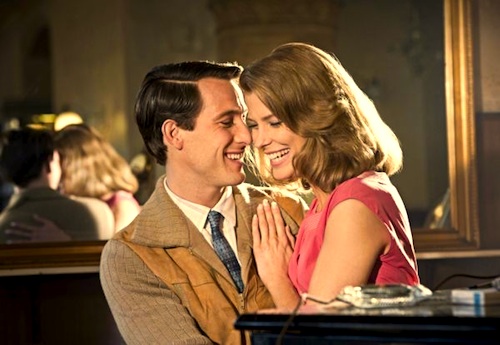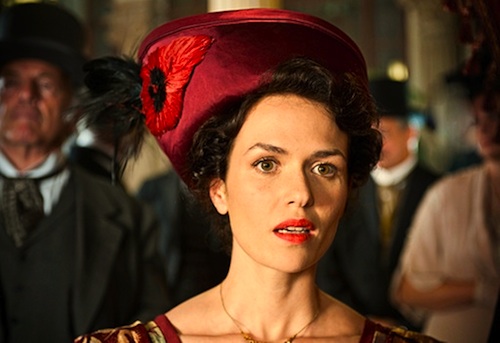
By Joe Bendel. How did an Austrian wearing a bathrobe conquer Germany? It had something to do with a Russian bassoon player. Based on crooner Udo Jürgens’ hybrid memoir-family saga novel, Miguel Alexandre’s two-part mini-series The Man with the Bassoon (trailer here) screens in its entirety tomorrow at MoMA as part of Kino!, their annual celebration of contemporary German cinema.
After completing the expected encore in his traditional white bathrobe, modern day Jürgens (playing himself) receives word from Moscow: a long lost family retainer has a significant heirloom he wishes to return to Jürgens. It is a statue of a man playing a bassoon. Thus begins the first of many flashbacks.
Jürgens’ grandfather Heinrich Bockelmann decides to immigrate to Russia after hearing the beautiful, lamenting Russian melodies of a street musician. Amassing great wealth as the Czar’s family banker, Bockelmann credits his success to that bassoon player. For their anniversary, his wife gives him a statuette of the bassoon player, which quickly becomes the guardian of the family’s good fortune. However, dark clouds are on the horizon. With socialist revolutionaries campaigning against the German economic elite, the Czarist government dispossesses and imprisons Bockelmann and his aristocratic countrymen, soon after Russia’s entry into WWI.
Escaping Russia with their children, Bockelmann’s wife eventually re-establishes the family dynasty in Austria. As viewers know from several flashbacks, Bockelmann’s son Rudi eventually becomes a provincial burgomaster and National Socialist Party member. Yet, as the war drags on, Rudi Bockelmann runs afoul of his more zealous colleagues. We know he will survive though, because in yet another flashback story-arc, we see Rudi Bockelmann is the only member of the elite Austrian family to encourage his aimless son Udo to pursue his musical ambitions.
Spanning over one hundred years, Bassoon is definitely an epic, they-don’t-make-them-like-they-used-to miniseries. While many consider the boundary fact and fiction therein to be somewhat porous, the bassoon must be true. (Anyone making this story up would have chosen a different instrument.) Though the Bockelmann family’s dark days are mostly caused by the Nazis and the Czarists, the depiction of the xenophobic and anti-Semitic Russian revolutionary factions is also an intriguing footnote within the Bassoon. In fact, the historical episodes featuring Jürgens’ father and grandfather are considerably stronger than his own rise-to-fame story. Frankly, a lot of viewers will want to see Jürgens (as he comes to be known) suffer more for his art.

Still, Jürgens’ music may surprise some viewers. His rendition of “There Will Never Be Another You” heard several times in Bassoon swings politely enough. Starting very squarely in a jazz bag, he became something like a cross between Sinatra and Czech vocalist Karel Gott (if that name means anything to you). Although he never really caught on here, he had his admirers, including Sammy Davis, Jr., who covered a few of his tunes.
Jürgens is also sufficiently convincing playing himself, but Christian Berkel carries the heaviest load as the Bockelmann patriarch, Heinrich. Fittingly, he somewhat resembles miniseries king Richard Chamberlain, aging decades while exuding an aura of integrity.In contrast, David Rott is a rather weak screen presence as the young Jürgens on the brink of superstardom.
A large-scale, richly detailed period production, Bassoon covers quite a bit of ground. Anyone at all intrigued by Jürgens’ sweeping family story should definitely watch it at MoMA, because it is hard to imagine there will be lot of opportunities to catch up with it in the future. Both parts one and two screen back-to-back tomorrow (4/26), with Jürgens and Alexandre appearing afterward for a session of Q&A, as well as this Saturday (4/28), as part of this year’s Kino! at MoMA.
LFM GRADE: B
Posted on April 26th, 2012 at 10:20pm.